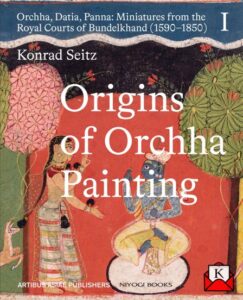Konrad Seitz’s Book Origins of Orchha Painting Explores Features Of Early Orchha Painting Period


Niyogi Books announced the release of its new book Origins of Orchha Painting: Orchha, Datia, Panna: Miniatures from the Royal Courts of Bundelkhand(1590–1850) Vol. 1 by Konrad Seitz.
This book is the first of the three volumes which is an improved and expanded edition of the author’s two-volume, German-language book from 2015, Orchha, Datia, Panna: “Malwa”-Miniaturen von den rajputischenHöfenBundelkhands, 1580–1820.
Over 100 photos of magnificent miniature paintings from this school are included in this book of the series, which explores the distinctive characteristics of the early Orchha painting period (1590–1605).
According to the book’s author, Konrad Seitz, the Orchha School was not only the first Rajput school but also the only one that initially kept the native Indian style.
This book explores miniature paintings at the Bundelkhand royal courts of Orchha, Datia, and Panna. It aims to refute preconceived notions about the origins of these superb paintings by providing new information about their source. The earliest and most Indian of all the Rajput schools, the miniature school of Bundelkhand that originated in Orchha was the only one to follow a wholly indigenous style of painting at the time of its formation, “untainted” by the naturalism of imperial Mughal painting. Over 240 paintings from the author’s collection, many of which are being published here for the first time, have been interpreted and stylistically analyzed by the author in order to provide insight into how the school evolved from the late sixteenth century to the early years of British rule.
Readers are also introduced to the conceptual universe of Rajput miniature painting and the rasa aesthetic, which predates the contemporary reception aesthetic, in this book. Origins of Orchha Painting, the first book in the “Orchha, Datia, Panna: Miniatures from the Royal Courts of Bundelkhand (1590-1850)” series, discusses how early Rajput painting, which flourished at the Tomarcourt of Gwalior from roughly 1460 until the fall of the Hindu kingdom in 1518, influenced Orchha painting during its formative years, 1590-1605.
The next volumes, Stylistic Trends in Bundelkhand Painting, examine how this Rajput style evolved between 1605 and 1635, expanded to Datia following the breakup of Orchha in 1635, and then to Panna, the Bundelastate of Chattrasal, in the 1680s. Bundelkhand art came to an end with Chattrasal’s death in 1731, and the school did not enjoy an Indian summer at the court of Datia during the period of British suzerainty until much later, at the beginning of the nineteenth century.
Upon the book’s publication Director and COO of Niyogi Books, Trisha De Niyogi said “The paintings made in Orchha, Datia, and Panna in the 16th century can be better understood thanks to Konrad Seitz’s work. Both followers of contemporary art and devotees of Indian painting will be drawn to these works of art”.
The 254 pages book is priced at Rs 4500.
Priyanka Dutta
